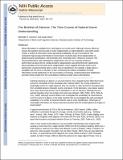| dc.contributor.author | Greene, Michelle R. | |
| dc.contributor.author | Oliva, Aude | |
| dc.date.accessioned | 2012-05-04T16:06:11Z | |
| dc.date.available | 2012-05-04T16:06:11Z | |
| dc.date.issued | 2009-04 | |
| dc.identifier.issn | 0956-7976 | |
| dc.identifier.issn | 1467-9280 | |
| dc.identifier.uri | http://hdl.handle.net/1721.1/70502 | |
| dc.description.abstract | What information is available from a brief glance at a novel scene? Although previous efforts to answer this question have focused on scene categorization or object detection, real-world scenes contain a wealth of information whose perceptual availability has yet to be explored. We compared image exposure thresholds in several tasks involving basic-level categorization or global-property classification. All thresholds were remarkably short: Observers achieved 75%-correct performance with presentations ranging from 19 to 67 ms, reaching maximum performance at about 100 ms. Global-property categorization was performed with significantly less presentation time than basic-level categorization, which suggests that there exists a time during early visual processing when a scene may be classified as, for example, a large space or navigable, but not yet as a mountain or lake. Comparing the relative availability of visual information reveals bottlenecks in the accumulation of meaning. Understanding these bottlenecks provides critical insight into the computations underlying rapid visual understanding. | en_US |
| dc.description.sponsorship | National Science Foundation (U.S.) (CAREER Award (0546262)) | en_US |
| dc.description.sponsorship | National Science Foundation (U.S.) (Grant 0705677) | en_US |
| dc.description.sponsorship | National Science Foundation (U.S.) (Graduate Research Fellowship) | en_US |
| dc.language.iso | en_US | |
| dc.publisher | Psychological Science | en_US |
| dc.relation.isversionof | http://dx.doi.org/10.1111/j.1467-9280.2009.02316.x | en_US |
| dc.rights | Creative Commons Attribution-Noncommercial-Share Alike 3.0 | en_US |
| dc.rights.uri | http://creativecommons.org/licenses/by-nc-sa/3.0/ | en_US |
| dc.source | PubMed Central | en_US |
| dc.title | The Briefest of Glances: The Time Course of Natural Scene Understanding | en_US |
| dc.type | Article | en_US |
| dc.identifier.citation | Greene, Michelle R., and Aude Oliva. “The Briefest of Glances: The Time Course of Natural Scene Understanding.” Psychological Science 20.4 (2009): 464–472. Web. | en_US |
| dc.contributor.department | Massachusetts Institute of Technology. Department of Brain and Cognitive Sciences | en_US |
| dc.contributor.approver | Oliva, Aude | |
| dc.contributor.mitauthor | Greene, Michelle R. | |
| dc.contributor.mitauthor | Oliva, Aude | |
| dc.relation.journal | Association for Psychological Science | en_US |
| dc.eprint.version | Author's final manuscript | en_US |
| dc.type.uri | http://purl.org/eprint/type/JournalArticle | en_US |
| eprint.status | http://purl.org/eprint/status/PeerReviewed | en_US |
| dspace.orderedauthors | Greene, Michelle R.; Oliva, Aude | en |
| mit.license | OPEN_ACCESS_POLICY | en_US |
| mit.metadata.status | Complete | |
